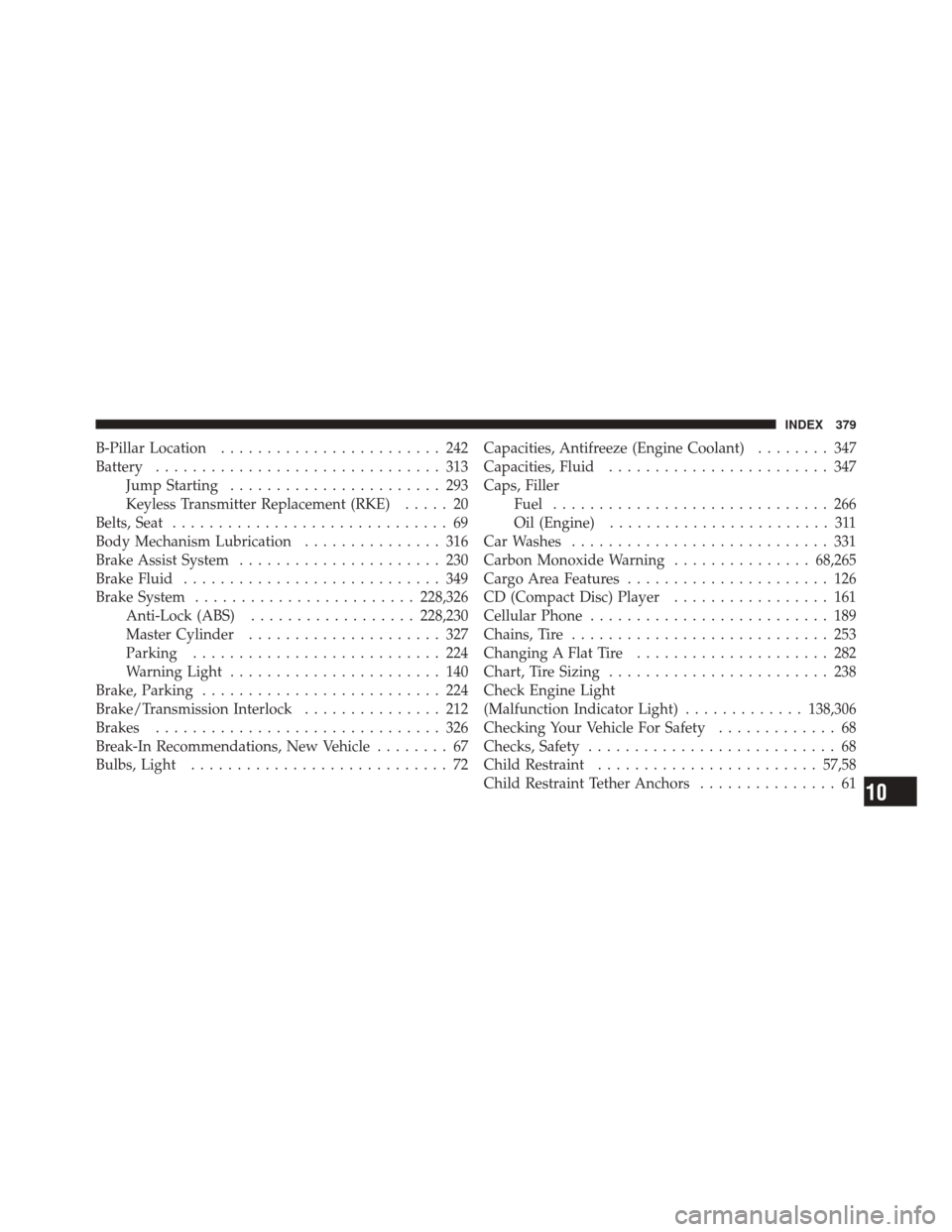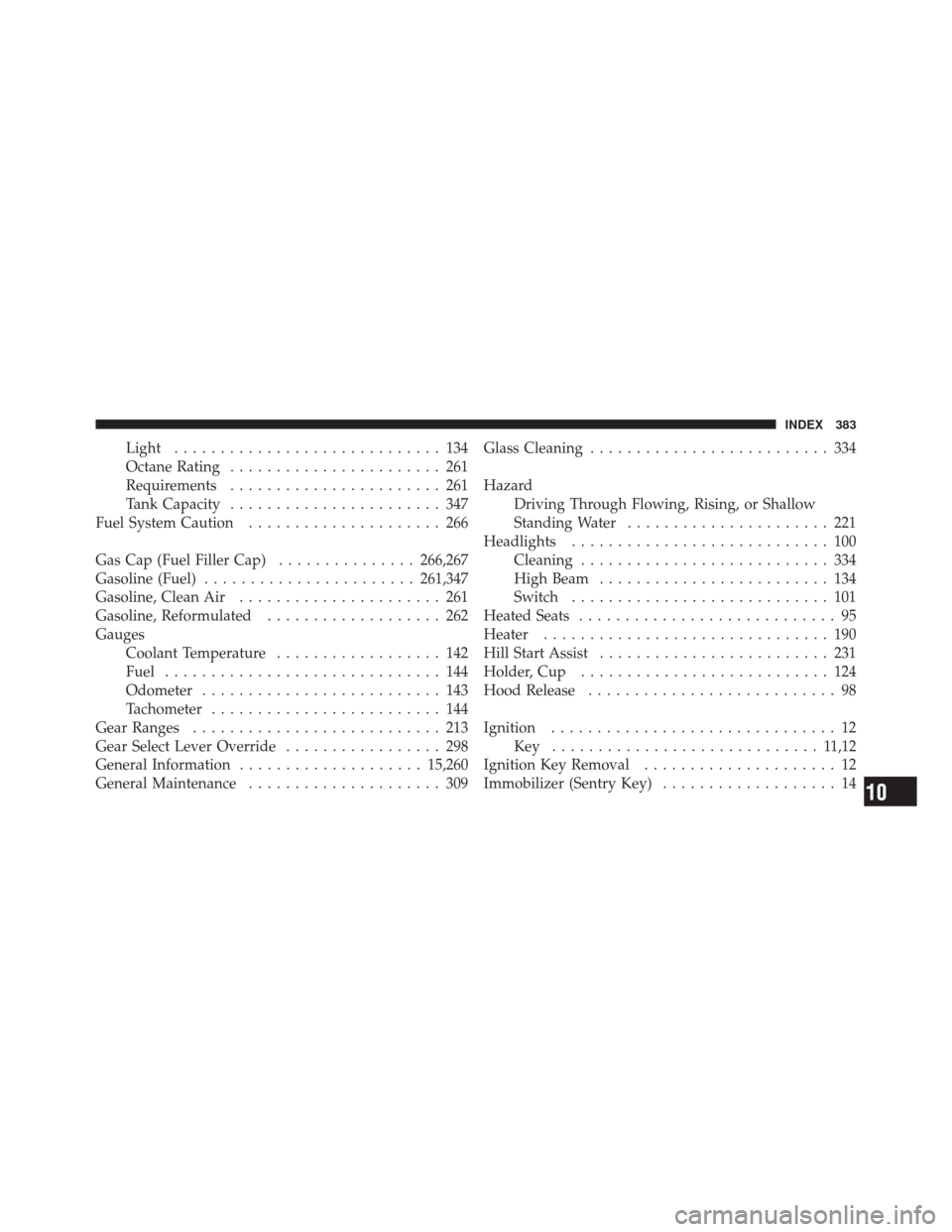Page 272 of 395
�Towing A Disabled Vehicle ............... 299
▫ With Ignition Key .................... 299 ▫
Without The Ignition Key .............. 300
� Enhanced Accident Response System ....... 301
270 WHAT TO DO IN EMERGENCIES
Page 273 of 395

HAZARD WARNING FLASHERS
The Hazard Warning flasher switch is located on the
instrument panel below the radio.Press the switch to turn on the Hazard Warning
flashers. When the switch is activated, all direc-
tional turn signals will flash on and off to warn
oncoming traffic of an emergency. Press the switch a
second time to turn off the Hazard Warning flashers.
Do not use this emergency warning system when the
vehicle is in motion. Use it when your vehicle is disabled
and it is creating a safety hazard for other motorists.
If it is necessary to leave the vehicle to go for service, the
Hazard Warning flashers will continue to operate with
the ignition key removed and the vehicle locked.
NOTE: With extended use, the Hazard Warning flashers
may wear down your battery.
IF YOUR ENGINE OVERHEATS
In any of the following situations, you can reduce the
potential for overheating by taking the appropriate ac-
tion.
•On the highways — slow down.
•In city traffic — while stopped, place the transmission
in NEUTRAL, but do not increase engine idle speed.
NOTE: There are steps that you can take to slow down
an impending overheat condition:
•If your air conditioner (A/C) is on, turn it off. The A/C
system adds heat to the engine cooling system and
turning the A/C off can help remove this heat.
•You can also turn the temperature control to maximum
heat, the mode control to floor and the blower control
to high. This allows the heater core to act as a
supplement to the radiator and aids in removing heat
from the engine cooling system.
6
WHAT TO DO IN EMERGENCIES 271
Page 301 of 395
3. Turn the ignition switch to the ON/RUN position
without starting the engine.
4. Press and maintain firm pressure on the brake pedal.
5. Using a small screwdriver or similar tool, push and
hold the override release lever in.6. Move the shift lever into the NEUTRAL position.
7. The vehicle may then be started in NEUTRAL.
8. Reinstall the shift lever override access cover.
TOWING A DISABLED VEHICLE
With Ignition Key
Automatic Transmission
•
Vehicle can be towed with the front wheels elevated.
•Vehicle can be towed on a flatbed truck (all wheels off
the ground).
CAUTION!
DO NOT flat tow any vehicle equipped with an
automatic transmission. Damage to the drivetrain
will result.
Shift Lever Override Access Cover6
WHAT TO DO IN EMERGENCIES 299
Page 302 of 395

Manual Transmission
•
Vehicle can be flat towed (all four wheels on the
ground) with the transmission in NEUTRAL.
•Vehicle can be towed with the front wheels elevated.
•Vehicle can be towed on a flatbed truck (all wheels off
the ground).
All Transmissions
If it is necessary to use the accessories while being towed
(wipers, defrosters, etc.), the key must be in the ON/
RUN position. Make certain the transmission remains in
NEUTRAL.
CAUTION!
•If the vehicle being towed requires steering, the
ignition switch must be in the ON/RUN position.(Continued)
CAUTION! (Continued)
•Do not attempt to use sling-type equipment when
towing. When securing the vehicle to a flatbed
truck, do not attach to front or rear suspension
components. Damage to your vehicle may result
from improper towing.
Without The Ignition Key
Special care must be taken when the vehicle is towed
with the ignition in the OFF/LOCK position. A dolly
should be used under the front wheels if the rear wheels
are raised. Proper towing equipment is necessary to
prevent damage to the vehicle.
Battery power is required to release the brake/
transmission interlock system (automatic transmission
only). There is a removable plug in the right side of the
shift lever housing that allows you to insert your finger to
300 WHAT TO DO IN EMERGENCIES
Page 303 of 395

override the system. The ignition key must be in the
ON/RUN position to use the override lever.
CAUTION!
Failure to follow these towing methods can cause
severe transmission damage. Such damage is not
covered by the New Vehicle Limited Warranty.
ENHANCED ACCIDENT RESPONSE SYSTEM
In the event of an impact causing airbag deployment, if
the communication network remains intact, and the
power remains intact, depending on the nature of the
event the ORC will determine whether to have the
Enhanced Accident Response System perform the follow-
ing functions:
•Cut off fuel to the engine.
•Flash hazard lights as long as the battery has power or
until the ignition key is turned off.
•Turn on the interior lights, which remain on as long as
the battery has power or until the ignition key is
removed.
•Unlock the doors automatically.
After the event occurs, when the system is active, the
message �Fuel Cutoff See Handbook� is displayed.
Carefully check the vehicle for fuel leaks in the engine
compartment and on the ground near the engine com-
partment and fuel tank before resetting the system and
starting the engine.
System Reset Procedure
After an impact causing airbag deployment, the left and
right turn signal lights, located in the instrument panel
cluster, will both be blinking, until the ignition is turned
off.
In order to move your vehicle to the side of the road you
must follow the system reset procedure.
6
WHAT TO DO IN EMERGENCIES 301
Page 309 of 395

For states that require an Inspection and Mainte-
nance (I/M), this check verifies the “Malfunction
Indicator Light (MIL)” is functioning and is not
on when the engine is running, and that the OBD II
system is ready for testing.
Normally, the OBD II system will be ready. The OBD II
system may notbe ready if your vehicle was recently
serviced, recently had a dead battery or a battery replace-
ment. If the OBD II system should be determined not
ready for the I/M test, your vehicle may fail the test.
Your vehicle has a simple ignition key-actuated test,
which you can use prior to going to the test station. To
check if your vehicle’s OBD II system is ready, you must
do the following:
1. Turn the ignition switch to the ON position, but do not
crank or start the engine. 2. If you crank or start the engine, you will have to start
this test over.
3. As soon as you turn the ignition switch to the ON
position, you will see the MIL symbol come on as part of
a normal bulb check.
4. Approximately 15 seconds later, one of two things will
happen:
a. The MIL will flash for about 10 seconds and then
return to being fully illuminated until you turn OFF
the ignition or start the engine. This means that your
vehicle’s OBD II system is not readyand you should
not proceed to the I/M station.
b. The MIL will not flash at all and will remain fully
illuminated until you turn OFF the ignition or start the
engine. This means that your vehicle’s OBD II system
is ready and you can proceed to the I/M station.
7
MAINTAINING YOUR VEHICLE 307
Page 381 of 395

B-Pillar Location........................ 242
Battery ............................... 313
Jump Starting ....................... 293
Keyless Transmitter Replacement (RKE) ..... 20
Belts, Seat .............................. 69
Body Mechanism Lubrication ............... 316
Brake Assist System ...................... 230
Brake Fluid ............................ 349
Brake System ........................ 228,326
Anti-Lock (ABS) .................. 228,230
Master Cylinder ..................... 327
Parking ........................... 224
Warning Light ....................... 140
Brake, Parking .......................... 224
Brake/Transmission Interlock ............... 212
Brakes ............................... 326
Break-In Recommendations, New Vehicle ........ 67
Bulbs, Light ............................ 72 Capacities, Antifreeze (Engine Coolant)
........ 347
Capacities, Fluid ........................ 347
Caps, Filler Fuel .............................. 266
Oil (Engine) ........................ 311
Car Washes ............................ 331
Carbon Monoxide Warning ...............68,265
Cargo Area Features ...................... 126
CD (Compact Disc) Player ................. 161
Cellular Phone .......................... 189
Chains, Tire ............................ 253
Changing A Flat Tire ..................... 282
Chart, Tire Sizing ........................ 238
Check Engine Light
(Malfunction Indicator Light) .............138,306
Checking Your Vehicle For Safety ............. 68
Checks, Safety ........................... 68
Child Restraint ........................ 57,58
Child Restraint Tether Anchors ............... 61
10
INDEX 379
Page 385 of 395

Light............................. 134
Octane Rating ....................... 261
Requirements ....................... 261
Tank Capacity ....................... 347
Fuel System Caution ..................... 266
Gas Cap (Fuel Filler Cap) ...............266,267
Gasoline (Fuel) ....................... 261,347
Gasoline, Clean Air ...................... 261
Gasoline, Reformulated ................... 262
Gauges Coolant Temperature .................. 142
Fuel .............................. 144
Odometer .......................... 143
Tachometer ......................... 144
Gear Ranges ........................... 213
Gear Select Lever Override ................. 298
General Information .................... 15,260
General Maintenance ..................... 309 Glass Cleaning
.......................... 334
Hazard Driving Through Flowing, Rising, or Shallow
Standing Water ...................... 221
Headlights ............................ 100
Cleaning ........................... 334
High Beam ......................... 134
Switch ............................ 101
Heated Seats ............................ 95
Heater ............................... 190
Hill Start Assist ......................... 231
Holder, Cup ........................... 124
Hood Release ........................... 98
Ignition ............................... 12
Key ............................. 1 1,12
Ignition Key Removal ..................... 12
Immobilizer (Sentry Key) ................... 14
10
INDEX 383